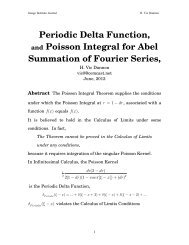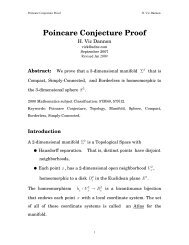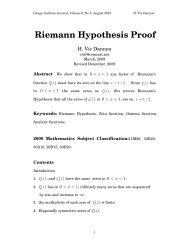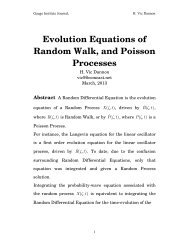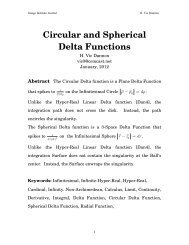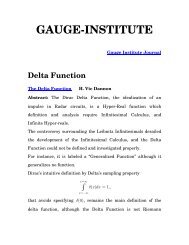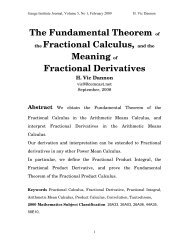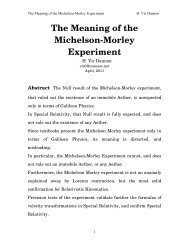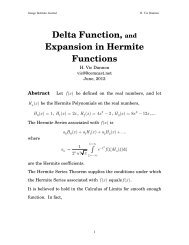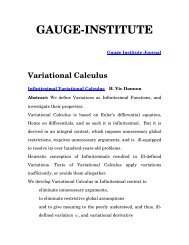4-space Curl in Vector Calculus - Gauge-institute.org
4-space Curl in Vector Calculus - Gauge-institute.org
4-space Curl in Vector Calculus - Gauge-institute.org
Create successful ePaper yourself
Turn your PDF publications into a flip-book with our unique Google optimized e-Paper software.
<strong>Gauge</strong> Institute Journal, Volume 9, No. 3, August 2013<br />
H. Vic Dannon<br />
The Aharonov-Bohm<br />
Magnetic Field is Not Zero<br />
and the Electron Spirals<br />
towards the Center<br />
H. Vic Dannon<br />
vic0@comcast.net<br />
June, 2013<br />
Abstract<br />
Aharonov and Bohm claimed that a Magnetic<br />
Potential may generate a vanish<strong>in</strong>g Magnetic Induction,<br />
ignor<strong>in</strong>g experimental evidence to the contrary.<br />
We show that the suppressed experiments were correct, and<br />
compute the non-negligible Magnetic Induction.<br />
Namely, if an electron encircles at radius r<br />
= b, a solenoid of<br />
radius<br />
a , that generates along its axis a uniform Magnetic<br />
Induction B , then, the Magnetic Induction at the electron is<br />
<br />
2<br />
<br />
aB<br />
the non-negligible B = , that forces the electron to<br />
b<br />
2<br />
1<br />
z<br />
spiral towards the center. This spiral<strong>in</strong>g motion<br />
o cannot happen <strong>in</strong> Aharonov-Bohm vanish<strong>in</strong>g field, and,<br />
be<strong>in</strong>g a global effect<br />
1
<strong>Gauge</strong> Institute Journal, Volume 9, No. 3, August 2013<br />
H. Vic Dannon<br />
o cannot be predicted from the Schröd<strong>in</strong>ger Equation,<br />
Eventually, the repetition of the Fallacy that the Induction<br />
is zero. became actual Physics.<br />
Thus, the significance of the non-exist<strong>in</strong>g Aharonov-Bohm<br />
Effect is nil. In particular,<br />
• The Magnetic Potential which is not observable, does<br />
not appear <strong>in</strong> the Lorentz Force, and is not unique,<br />
cannot replace the Magnetic Induction.<br />
• The Electromagnetic field is characterized fully by its<br />
<br />
<br />
Electric Field E , and Magnetic Induction B . The<br />
<br />
Electric Potential ϕ , and the Magnetic Potential A do<br />
not offer a more complete description of the<br />
electromagnetic Field.<br />
Keywords: Aharonov-Bohm Effect, Quantum Mechanics,<br />
Schröd<strong>in</strong>ger Equation, Electron, Electrodynamics, Magnetic<br />
Potential, Magnetic Flux, Magnetic Induction.<br />
Physics and Astronomy Classification Scheme 03.65.Ta<br />
2
<strong>Gauge</strong> Institute Journal, Volume 9, No. 3, August 2013<br />
H. Vic Dannon<br />
Contents<br />
Introduction<br />
1. The Non-existent Aharonov-Bohm Effect<br />
2. The Non-Vanish<strong>in</strong>g Magnetic Induction on the Electron<br />
3. The Magnetic Induction Forces the Electron to Spiral<br />
towards the Center<br />
4. The Insignificance of the Aharonov-Bohm Effect<br />
References.<br />
3
<strong>Gauge</strong> Institute Journal, Volume 9, No. 3, August 2013<br />
H. Vic Dannon<br />
Introduction<br />
<br />
Aharonov and Bohm claimed that a Magnetic Potential A<br />
<br />
may generate a vanish<strong>in</strong>g Magnetic Induction B .<br />
They claimed that if an electron encircles at radius r<br />
= b, a<br />
solenoid of radius a , that generates along its axis a uniform<br />
Magnetic Induction B , then, the Magnetic Induction at the<br />
electron vanishes. And the electron is affected by the Nonzero<br />
Magnetic Potential that appears <strong>in</strong> Schröd<strong>in</strong>ger’s<br />
Equation.<br />
The Aharonov-Bohm claims were avoided by most authors:<br />
The paradoxial Effect is not mentioned <strong>in</strong> Electrodynamics<br />
Texts, and is presented <strong>in</strong> few Quantum Mechanics Texts.<br />
Indeed,<br />
It does not seem credible that a Non-zero Magnetic<br />
<br />
<br />
Potential A will generate no Magnetic Induction B<br />
And<br />
Us<strong>in</strong>g the Schröd<strong>in</strong>ger Equation, that accounts for<br />
quantum effects, to make up for Electrodynamics<br />
effects, is like us<strong>in</strong>g a microscope to f<strong>in</strong>d a tree <strong>in</strong> a<br />
forest.<br />
4
<strong>Gauge</strong> Institute Journal, Volume 9, No. 3, August 2013<br />
H. Vic Dannon<br />
In particular,<br />
Experiments show a small non-zero Magnetic<br />
Induction, at the electron.<br />
Accord<strong>in</strong>g to Feynman, [Feynman, part II, Chapter 13, p. 5],<br />
“We observe experimentally that when a<br />
Solenoid is very long compared with its<br />
diameter, the field outside is very small<br />
compared with the field <strong>in</strong>side”<br />
Nevertheless, Feynman, believed that the Magnetic<br />
Induction vanishes, and gave the follow<strong>in</strong>g “proof”:<br />
“S<strong>in</strong>ce the field stays <strong>in</strong>side<br />
Then,<br />
(and has zero divergence),…”<br />
‣ “stays <strong>in</strong>side” <strong>in</strong>s<strong>in</strong>uates that outside it vanishes, and<br />
<br />
<br />
‣ “zero divergence”, Div B = 0 , <strong>in</strong>s<strong>in</strong>uates B = 0 . while<br />
<br />
it is clear that B = Constant.<br />
Thus, Feynman assumed that the Magnetic Induction is<br />
zero. In [Feynman, Part II, Chapter 15, p.11], he claimed<br />
“You remember that for a long Solenoid carry<strong>in</strong>g an<br />
electric current there is a B-field <strong>in</strong>side but none<br />
outside..”<br />
5
<strong>Gauge</strong> Institute Journal, Volume 9, No. 3, August 2013<br />
H. Vic Dannon<br />
Assum<strong>in</strong>g zero Induction, he described electron <strong>in</strong>terference<br />
that proved that the Induction is zero…(pages 11-12 there).<br />
Feynman concluded with<br />
“Precisely this experiment has recently been done. It<br />
is a very, very difficult experiment. Because the<br />
wavelength of the electrons is so small, the apparatus<br />
must be on a t<strong>in</strong>y scale to observe the <strong>in</strong>terference…”<br />
Why Feynman preferred an experiment that assumes its<br />
false result over experimental evidence that contradicts it,<br />
will never be known.<br />
Clearly, the Aharonov-Bohm Effect is based on repetition of<br />
the Fallacy that the Induction is zero. Eventually, that<br />
repeated Fallacy became actual Physics.<br />
Follow<strong>in</strong>g our recent construction of Space-time<br />
Electrodynamics, we considered the Aharonov-Bohm Effect<br />
<strong>in</strong> Space-time.<br />
We exam<strong>in</strong>ed the Aharonov-Bohm Effect <strong>in</strong> <strong>space</strong>-time,<br />
expect<strong>in</strong>g to f<strong>in</strong>d that the time component of the Magnetic<br />
Induction exists, and applies to the electron.<br />
We found that Space-time Electrodynamics was not needed<br />
to resolve the Aharonov-Bohm Paradox.<br />
6
<strong>Gauge</strong> Institute Journal, Volume 9, No. 3, August 2013<br />
H. Vic Dannon<br />
The Aharonov-Bohm Effect does not exist already <strong>in</strong> 3-<strong>space</strong>.<br />
Aharonov-Bohm vanish<strong>in</strong>g of the Magnetic Induction is a<br />
Fallacy, due to ignorance of elementary <strong>Vector</strong> Analysis, and<br />
confusion about the relevance of Quantum Mechanics.<br />
Its proponents were anxious to keep the Magnetic Potential<br />
<strong>in</strong> the Schröd<strong>in</strong>ger Equation, <strong>in</strong>stead of f<strong>in</strong>d<strong>in</strong>g how the<br />
Magnetic Induction may replace the Potential <strong>in</strong> that<br />
Equation.<br />
We show that the Aharonov-Bohm Effect is Pure Fiction.<br />
As the suppressed experimental evidence shows, the<br />
Magnetic Induction at the electron does not vanish. It has a<br />
non-zero value.<br />
That Magnetic Induction generates a Lorentz Force on the<br />
electron <strong>in</strong> the direction of the center, and results <strong>in</strong> a<br />
Magnetron-like effect. The electron spirals towards the<br />
solenoid.<br />
7
<strong>Gauge</strong> Institute Journal, Volume 9, No. 3, August 2013<br />
H. Vic Dannon<br />
1.<br />
The Non-existent Aharonov-<br />
Bohm Effect<br />
A Solenoid with cross-section radius a , generates a Uniform<br />
Magnetic Induction<br />
<br />
B = B1 z ,<br />
which is seem<strong>in</strong>gly conf<strong>in</strong>ed to the <strong>in</strong>terior of the Solenoid.<br />
And an electron encircles the Solenoid, at radius<br />
b<br />
> a.<br />
In the electron’s plane,<br />
8
<strong>Gauge</strong> Institute Journal, Volume 9, No. 3, August 2013<br />
H. Vic Dannon<br />
The Magnetic Flux of the Solenoid is its cross-section area<br />
πa 2<br />
, times the Magnetic Induction density B ,<br />
2<br />
π aB.<br />
The Magnetic Potential at the Electron is<br />
where<br />
<br />
1 θ<br />
2 2<br />
πaB<br />
aB<br />
= 1 θ<br />
= 1<br />
, θ<br />
A<br />
2πb<br />
2b<br />
is the unit vector <strong>in</strong> the direction of <strong>in</strong>creas<strong>in</strong>g θ , <strong>in</strong><br />
the cyl<strong>in</strong>drical coord<strong>in</strong>ate system ( r, θ, z)<br />
.<br />
Aharonov-Bohm claimed that the Magnetic Induction out of<br />
the solenoid vanishes, and the effect of the Magnetic<br />
Potential A <br />
on the electron requires the Schröd<strong>in</strong>ger<br />
Equation. In fact,<br />
• the Magnetic Potential generates a non-zero Magnetic<br />
Induction that applies to the electron, and<br />
• the Schröd<strong>in</strong>ger Equation is not necessary for<br />
elementary Electrodynamics.<br />
9
<strong>Gauge</strong> Institute Journal, Volume 9, No. 3, August 2013<br />
H. Vic Dannon<br />
2.<br />
The Non-Vanish<strong>in</strong>g Magnetic<br />
Induction on the Electron<br />
Clearly,<br />
Hence,<br />
<br />
A<br />
<br />
1θ =− 1x<br />
s<strong>in</strong>θ + 1y<br />
cos<br />
θ<br />
=<br />
y <br />
=− 1x<br />
+ 1<br />
b<br />
2<br />
aB<br />
2b<br />
<br />
1<br />
θ<br />
y<br />
x<br />
b<br />
2<br />
<br />
2<br />
<br />
=− y1 + x1<br />
aB aB<br />
2 2<br />
2b<br />
x 2b<br />
y<br />
10
<strong>Gauge</strong> Institute Journal, Volume 9, No. 3, August 2013<br />
H. Vic Dannon<br />
Therefore,<br />
2<br />
aB<br />
= x<br />
2 ⎢ ⎥<br />
2b<br />
⎡ y ⎤<br />
−<br />
⎢ ⎥ .<br />
0<br />
⎢⎣<br />
⎥⎦<br />
B<br />
=∇× A<br />
<br />
⎡−y<br />
⎤<br />
2<br />
<br />
aB<br />
= ∇× x<br />
2<br />
2b<br />
0<br />
⎢⎣<br />
⎥⎦<br />
<br />
1 1 1<br />
2<br />
aB<br />
2<br />
2b<br />
−y<br />
x y z<br />
= ∂ ∂ ∂<br />
x y z<br />
x<br />
0<br />
2<br />
aB<br />
= 0<br />
2 ⎢ ⎥<br />
2b<br />
⎡0<br />
⎤<br />
⎢ ⎥<br />
2<br />
⎢⎣<br />
⎥⎦<br />
=<br />
2<br />
aB<br />
b<br />
2<br />
1<br />
<br />
.<br />
z<br />
That is, the Magnetic Induction at the electron, at r<br />
= b, is<br />
the non-zero<br />
<br />
2<br />
<br />
aB1<br />
2 .<br />
B =<br />
This field is not negligible!<br />
For <strong>in</strong>stance, if the electron orbit has radius b = 2a, then the<br />
<br />
Magnetic Induction is<br />
B<br />
B = , which is far from negligible.<br />
1 4 z<br />
b<br />
z<br />
11
<strong>Gauge</strong> Institute Journal, Volume 9, No. 3, August 2013<br />
H. Vic Dannon<br />
3.<br />
The Magnetic Induction Forces<br />
the Electron to Spiral towards<br />
the Center<br />
The Lorentz Force on the electron is<br />
<br />
2 2<br />
aB<br />
aB<br />
qv<br />
e e1θ × <br />
1<br />
2<br />
b z = qv<br />
e e<br />
1 <br />
b r,<br />
where ve<br />
is the electron speed, and qe<br />
is the electron charge.<br />
S<strong>in</strong>ce ve<br />
= ωe b , where ωe<br />
is the angular speed, the Lorentz<br />
Force on the electron is<br />
2<br />
<br />
q ω<br />
aB1<br />
.<br />
e e b r<br />
S<strong>in</strong>ce the electron charge<br />
q e<br />
is negative, the force is<br />
aB<br />
( −q<br />
) ω ( −1<br />
).<br />
2<br />
e e b r<br />
<br />
The force direction is opposite to 1 . That is, the force<br />
pushes the electron towards the center, and <strong>in</strong>creases as the<br />
electron gets closer to the solenoid<br />
r<br />
12
<strong>Gauge</strong> Institute Journal, Volume 9, No. 3, August 2013<br />
H. Vic Dannon<br />
The force results <strong>in</strong> a path, similar to the one that appears <strong>in</strong><br />
Magnetrons [H<strong>in</strong>kel].<br />
A Magnetron is a circular cavity between two concentric<br />
cyl<strong>in</strong>ders. The negatively charged <strong>in</strong>ternal cyl<strong>in</strong>der serves as<br />
a Cathode, and the positively charged external cyl<strong>in</strong>der<br />
serves as an Anode. The potential gradient will accelerate an<br />
electron emitted from the Cathode to the Anode. A magnetic<br />
field perpendicular to the electron path generates a Lorentz<br />
Force that curves each electron path between the cyl<strong>in</strong>ders<br />
<strong>in</strong>to a cycloid arc, <strong>in</strong> the direction of the cathode. As the<br />
negative cathode will repel the electron, and the positive<br />
Anode will attract it, the electron will slow, and come to a<br />
halt. Then, the process will start aga<strong>in</strong>. The electron motion<br />
through consecutive cycloid arcs transfers electromagnetic<br />
energy to nearby cavities <strong>in</strong> the Anode block, and keeps<br />
them oscillat<strong>in</strong>g, at a characteristic frequency determ<strong>in</strong>ed by<br />
their capacitance and <strong>in</strong>ductivity.<br />
In the Aharonov-Bohm setup, the potential gradient that<br />
drives the electron <strong>in</strong> the circle, must be along the loop, <strong>in</strong><br />
<br />
the direction of 1 θ<br />
.<br />
Therefore, the electron will not come to a halt before it<br />
13
<strong>Gauge</strong> Institute Journal, Volume 9, No. 3, August 2013<br />
H. Vic Dannon<br />
reaches the solenoid. The electron will spiral towards the<br />
solenoid, and collide with it.<br />
This spiral<strong>in</strong>g motion<br />
o cannot happen <strong>in</strong> the Aharonov-Bohm vanish<strong>in</strong>g field,<br />
and, be<strong>in</strong>g a global effect,<br />
o cannot be predicted from the Schröd<strong>in</strong>ger Equation.<br />
14
<strong>Gauge</strong> Institute Journal, Volume 9, No. 3, August 2013<br />
H. Vic Dannon<br />
4.<br />
The <strong>in</strong>significance of the<br />
Aharonov-Bohm Effect<br />
The significance of the non-exist<strong>in</strong>g Aharonov-Bohm Effect is<br />
nil. In particular,<br />
• The Magnetic Potential which is not observable, does<br />
not appear <strong>in</strong> the Lorentz Force, and is not unique,<br />
cannot replace the Magnetic Induction.<br />
• The Electromagnetic field is characterized fully by its<br />
Electric Field<br />
E , and Magnetic Induction B . The<br />
<br />
Electric Potential ϕ , and the Magnetic Potential A do<br />
not offer a more complete description of the<br />
electromagnetic Field.<br />
Wikipedia lists many more consequences of the non-existent<br />
Aharonov Bohm effect.<br />
Any consequence of the non-existent effect, may be an<br />
<strong>in</strong>significant fallacy too.<br />
15
<strong>Gauge</strong> Institute Journal, Volume 9, No. 3, August 2013<br />
H. Vic Dannon<br />
References<br />
[Aharonov-Bohm] Y. Aharonov, and D. Bohm, Physical Review 115,<br />
p.485, (1959).<br />
[Dan1] H. Vic Dannon, “Inf<strong>in</strong>itesimal <strong>Vector</strong> <strong>Calculus</strong>” posted to<br />
www.gauge-<strong>in</strong>stitute.<strong>org</strong> December, 2011;<br />
[Dan2] H. Vic Dannon, “4-<strong>space</strong> <strong>Curl</strong> is a 4-<strong>Vector</strong>” posted to<br />
www.gauge-<strong>in</strong>stitute.<strong>org</strong>, January, 2012;<br />
[Dan3] H. Vic Dannon, “Space-Time Eletrodynmaics and Magnetic<br />
Monopoles” posted to www.gauge-<strong>in</strong>stitute.<strong>org</strong>, June, 2013;<br />
[Feynman] Richard Feynman, Robert Leighton, Mathew Sands, “The<br />
Feynman Lectures on Physics Ma<strong>in</strong>ly Electromagnetism and Matter”,<br />
Addison Wesley, 1964.<br />
[Griffiths] David J. Griffiths, “Introduction to Quantum Mechanics”<br />
Prentice Hall, 1995.<br />
[H<strong>in</strong>kel] K. H<strong>in</strong>kel, “Magnetrons”, John Rider Publisher, 1961.<br />
[Hughes/Gaylord] William Hughes, and Eber Gaylord, “Basic<br />
Equations of Eng<strong>in</strong>eer<strong>in</strong>g Science” Schaum, 1964.<br />
http://en.wikipedia.<strong>org</strong>/wiki/Aharonov-Bohm<br />
16



